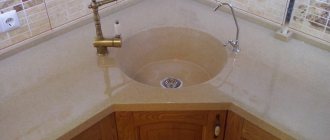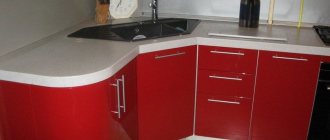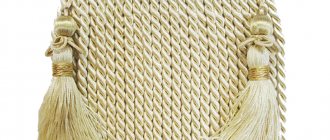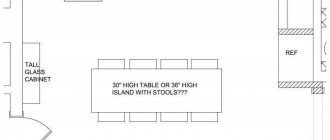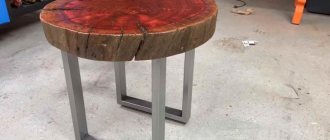From this article you will learn:
- What shapes do kitchen sinks come in?
- What sizes are considered optimal for a kitchen sink?
- What types of kitchen sinks are there by material?
- What types of kitchen sinks are there according to installation method?
- What is important to consider when choosing a kitchen sink
It is unlikely that there will be people who call washing dishes their favorite pastime. But this process can be significantly simplified by choosing a convenient kitchen sink. When purchasing it, you need to take into account many factors: the overall interior of the room, the dimensions of the room, the number of residents of the house, and so on. In pursuit of an attractive appearance of the product, do not forget that its main advantages should be practicality and functionality: they determine how comfortable it will be for you to cook and wash dishes. Next, we will tell you what types of kitchen sinks there are.
Which material is better
Some time ago, buying a stainless steel sink was incredibly lucky. Mostly enameled ones were used. The idea, of course, is not bad, but the execution was extremely poor. Today there are a lot of options:
- Stainless steel. It may or may not be polished. The most durable option, easy to clean. But a polished stainless steel sink will eventually become covered with a network of scratches and lose its appearance. Unpolished ones look good, but cost more. Well, the main drawback is the noise when a stream of water falls. To make the sink “quieter,” a layer of soundproofing material is glued to the bottom.
- Copper. These are not cheap options at all. Suitable for special kitchen interiors. Difficult to care for (requires special products) and is not widespread.
Metal kitchen sinks: copper and stainless steel without wings - Made from artificial stone. The natural component (stone chips and quartz sand) is diluted with a polymer binder, and the resulting composition is poured into molds. This is how you get a stone sink. There are different types of material: based on granite, quartz, marble, quartz sand. They are usually named after the “stone” component: granite, marble, quartz kitchen sink. Some companies develop special compositions, but they differ in the polymer binder, which gives the product certain performance properties (for example, Silgranit from the German company Blanco).
Stone and glass (glass top) sinks are a more modern choice - Ceramic. Ceramics - porcelain or earthenware - are not so popular for kitchen sinks, but they are also available.
There are those that appeared not so long ago - with a glass panel (pictured on the left). This is a stainless steel sink with a tempered glass surface. This option will look great next to a hob of the same color. And don't be afraid that the glass will crack. It has been hardened, so it is difficult to damage it.
No. 4. Steel thickness
The thickness of the steel determines the quality of the finished sink. The thicker the material, the better the product will cope with shock loads, withstand the weight of heavy dishes and make less noise when it comes into contact with drops of water. Steel that is too thin will vibrate violently when the water jet hits it and may even bend under pans filled with water. There are cases when thin stainless steel was even pierced with a knife, but we are talking about handicrafts.
The thickness of the steel sheet ranges from 0.4 to 1.2 mm , while stamped sinks are always thinner than welded ones. In any case, it is not recommended to use a sink with a thickness of less than 0.6 mm . In the case of welded products, this parameter increases to 1 mm.
Stainless steel or stone?
It is usually difficult to decide which is better: a stainless steel or stone kitchen sink. Let's first talk about the advantages of each type. Stainless steel is not afraid of shock loads, is easy to clean, and has a long service life. Stone kitchen sinks are quiet, come in different colors, and have a wider selection of shapes.
To decide which kitchen sink is better - artificial stone or stainless steel, you need to know the pros and cons of both materials
Now about the disadvantages. Stainless steel: noisy, there are only two color options, polished steel gets scratched and it’s impossible to remove scratches. If there is a high salt content in the water, stains remain on the polished surface. So, in order for your sink to look neat, you need to take care of it. Inexpensive sinks made from stone chips require careful handling: scratches and chips may occur. Some - light - may turn yellow or darken over time. The problem can be solved by cleaning, but it can be annoying. If the content of stone chips or quartz is low, an artificial stone sink may be afraid of high temperatures. So that you don’t care, just make sure the product is of normal quality.
How critical are chips and scratches on granite sinks?
You should not drop anything heavy into them. No, nothing will happen from a dropped cup or plate. The dishes will break, but the sink will most likely remain as it was. A small chip may appear, depending on how and where it falls. But if you drop a heavy pot or frying pan, you can expect it to chip with a high probability.
The ability to choose colors is very important when creating an interior
The good news is that scratches can be sanded out. For this, sometimes the abrasive part of a sponge is enough, sometimes you need to use fine-grain sandpaper. The degree of polishing depends on the quality of the material from which the sink is made. If the composition is painted in the mass (the dye is added before molding), it can be sanded to any depth.
A black sink on a black countertop—this was never possible before
Chips on granite, quartz and other composite sinks are also easy to repair. Most of . It is a pigment in powder form and a polymer binder. By mixing a certain amount, you get a repair composition. It is applied to the chipped area and sanded after drying. Often the former chip then takes a long time to look for and may not be found.
The best choice is a double stainless steel sink
There are many options for double sinks. However, there is a common feature - the separation of bowl capacities using a divider. As a rule, one of the bowls is larger and deeper, the other is smaller. Although you can also find an option for dividing equally. The most optimal bowl ratio is 60/40.
When choosing a model with a double bowl, pay special attention to the material from which it is made. A stainless steel sink is considered a priority, since this option is durable and resistant to various damages. If desired, you can place a special mesh in the sink, which will significantly extend the service life of the sink. In addition, it doesn’t matter at all what style your kitchen space is decorated in. This type of sink will fit perfectly into any interior.
Sink forms
Choosing a sink for the kitchen is not so easy. There are so many offers that it's easy to get lost. The diversity of species is stunning. Sometimes even the shape is not so easy to decide on, but the shapes of kitchen sinks are:
- Angular. The best option for L and P-shaped kitchen sets. Installing a sink in a corner allows you to make the best use of this space.
Corner sinks - convenient and functional - Rectangular/square. The most common, as they allow you to optimally use the area. They are convenient for washing dishes of any size. The same baking sheets, skewers, etc.
- Round. They seem to be the most original, but in practice they are inconvenient - it is a problem to wash the baking sheet and other large dishes, since the dimensions of the bowl are much smaller. Models without a side table may look good, but they are very inconvenient. In models with a wing, it is usually small in size, which also doesn’t help much.
Oval sinks are very rare - Oval. Quite rare. Most often it is a round sink, complemented by a second bowl or table of the same type next to it. The shape of the “wing” is just oval. And an oval sink bowl is extremely rare.
There is also a type called modular kitchen sinks. They are made of artificial stone and cast immediately with the countertop. This type is made to your measurements, so local companies do this. It is difficult to say how high quality the product will be - it depends on the specific company.
An example of a composite sink - cast immediately with the countertop
If we talk about choosing a shape, then more often, after all, they settle on rectangular or square. In addition to being a classic, they are the most convenient to use.
Even classic square sinks are different in appearance
Only rectangular ones can have more or less rounded corners. Sharp corners look more graphic, but they are more difficult to maintain - it is harder to clean out the dirt that accumulates there.
Optimal sizes and shapes
There are three main types of sinks - overhead, mortise and mounted under the countertop, but in everyday life the first two options are most often used.
With two bowls
Experts recommend paying attention to the option with two bowls. You can safely combine two things at the same time, which is very convenient. Isn't it wonderful? You can wash dirty dishes and peel vegetables without dirtying the countertop or taking up extra space.
When choosing a sink, its size matters. The most optimal depth is approximately 18 cm.
It is worth paying attention to models with so-called wings, maybe one or two wings. They will come in handy when you need to defrost meat, fish, vegetables or will be useful as a stand for hot food.
Round (oval)
Suitable for corner options, in which the corner table set is presented in the form of a trapezoid. But don’t neglect this form even if your goal is to increase the work surface space. After all, as a rule, the volume of such sinks goes deep.
Square and rectangular
This is a classic of the genre. Perfect for conservative people who prefer simple shapes. It has been proven over the centuries that they are very functional.
Bowls and their varieties
Sometimes the size of the sink is very important - in small kitchens, narrow countertops. In this case, a sink with sides is usually used. It is simply a bowl, along the perimeter or circumference of which there is a thickening or protrusion - a rim. The width of the side is several centimeters.
The second type is a kitchen sink with a work surface - a wing to the right or left of the bowl. Some models are “reversible”, meaning they can be installed either way. Also called a “wash with a wing”. They are interesting because you can lay out washed dishes on the surface, leave food, etc. The draining liquid ends up in the sink.
Kitchen sink with two bowls. Moreover, there are two options:
- both bowls are the same size (can be called a double sink);
- one bowl is larger, the other is noticeably smaller (in size and/or depth).
One and a half sinks - two bowls of different sizes
Two identical bowls can be used to wash dishes faster: one bowl contains soapy water, the other contains clean water for rinsing. The second option is also called a one-and-a-half sink. The second - a smaller vessel is used for defrosting food, for squeezing out excess liquid, etc. You can put a mesh (called a colander) in a shallow bowl, which increases functionality.
There are also kitchen sinks with two bowls and a wing. They are good for large kitchens. In principle, they can be used both under a window and on a long working wall.
Additional functions
Accessories are available for sinks that significantly speed up and facilitate home kitchen work. These are colanders, baskets, dryers, colanders, cutting boards equipped with grooves, etc. With their help, defrosting, washing and drying food is much easier.
- Waste shredder. Mounted directly under the kitchen sink, it is used to crush food waste to prevent clogging of the drain.
- Colander. The accessory is a tray equipped with several holes. It copies the shape of the bowl. Using a colander simplifies the process of defrosting, washing, and drying fruits and vegetables.
- Automatic valve When used, this accessory is inserted into the drain hole. By pressing it, you can block the drain, which will allow you to draw water into the bowl to soak vegetables, fruits or dishes in it.
- Cutting boards. The dimensions of these boards correspond to the dimensions of the bowl. They help to rationally use the work area, freeing up space on the kitchen countertop for other processes.
- Detergent dispenser. Built next to the mixer.
- Faucet for filtered water. Very comfortably
- Placemats for cutlery. Organize the storage system in the kitchen more neatly and rationally.
Installation method
There are three ways to install a sink in a countertop:
- Mortise. This is when a bowl-shaped cutout is made in the countertop and a sink is inserted into it. It is held in place by the sides, although there are additional fastenings.
Methods for installing a kitchen sink into a countertop - Under-table installation. Sinks that are attached to the bottom of the countertop. The cutout in the tabletop is made strictly according to the size of the bowl. Moreover, the cut must be processed (edged or polished if the countertop is made of artificial stone).
Sink with under-counter installation in the countertop - On the same level as the countertop. Only certain types of sinks are installed this way. In principle, you can install a regular sink, but to do this you will have to mill a groove in the countertop. And this will have to be done very accurately.
You need to choose the method of installation in the countertop before you decide on the model - each installation has its own design options, its own fasteners, which come with the sink.
Double mortise sink Stylo 2B (Teka)
One of the popular European manufacturers Teka (Spain) offers the consumer a double mortise sink Stylo 2B made of stainless steel (chrome 18/nickel 10) of a rectangular shape, the coating of which is polished. Ideal for placement on a sink cabinet 80 cm wide (no less).
The size of the bowls of the Teka Stylo 2B sink is 36 x41.7 x 17 cm, and the overall dimensions of the sink itself (WxDxH) are 82.8 x 48.5 x 17 cm. The sink is designed in such a way that there is a drain hole with a 3 ½” basket valve . In addition, the kit includes a siphon.
Sink dimensions
Since the kitchen sink is installed in the cabinet countertop, it cannot be larger in size. Please note that it is very difficult to find options for cabinets of small depth - less than 60 cm. Unless the sink will only have a side and is for surface mounting.
The kitchen sink can be of different sizes
When choosing a specific model, you must first know the distance between the front and back walls of the cabinet and the dimensions of the countertop. Why both? Because usually the tabletop is larger than the body. In this case, the cutout in the tabletop should be at some distance from the walls of the frame. For under-table mounting and level installation, monitor the following parameters:
- The optimal distance from the back and front walls of the cabinet frame is 5 cm. The distance at the back can be greater - it will be more convenient to maintain cleanliness. If there is a sufficiently large gap between the edge of the sink and the wall, you can install household chemicals, ideally, choose a dispenser to keep everything you need at hand.
- You can place the kitchen sink flush with the back edge of the countertop, but cleaning will be more troublesome.
- You should not move the sink too far from the front edge of the countertop - it will be inconvenient to use. But too close is also not very good - the clothes will be wet from the splashes.
If you are considering purchasing a kitchen sink with two bowls or a drain, you will also need the length of the cabinet for the sink. Most often it is cut in symmetrically relative to the center, but this largely depends on the location of the furniture.
The installation opening of the kitchen sink should be less than or equal to the dimensions of the frame
If you are more comfortable with overhead (built-in, inset) installation, it is better if the sink has the same dimensions as the countertop. If this is not achievable, and the difference in depth is small, the entire gap is left either in front or behind. “Divide” makes sense if the difference in width is more than 8 cm.
Generally speaking, the standard is a square kitchen sink with dimensions of 500*500 mm or 600*600 mm. In our apartments, not everyone can install them. Therefore, for small kitchens there are narrower sinks - from 400 mm. But they are mainly for under-table mounting, although you can also find overhead ones.
Bowl depth
In addition to the size of the sink, you will also need to choose the depth of the bowl. The optimal depth is 17-19 cm. Smaller models are not so convenient - water splashes. There are also deeper ones - up to 25-26 cm. They are intended for cafes and restaurants, where there is a lot of dishes, and the size of the pots/vats is much larger. But if you use large dishes for cooking, this option may be more convenient for you.
Optimal depth - 17-19 cm
If you decide to install a small round bowl, be prepared for the fact that they will all be 20 cm deep or more. Smaller ones are difficult to find - only Chinese ones.
What types of kitchen sinks are there according to installation method?
When choosing a kitchen sink, you should pay attention not only to the dimensions, appearance and material from which it is made, but also to the method of its installation. Depending on the method by which the products are installed, they are divided into four types: overhead, mortise, integrated and under-table.
When installing your sink, there are a few important things you should keep in mind. It is not advisable to install the sink near a gas stove. The most convenient option would be a placement in which the product is located between the refrigerator and the cooking area, not far from the cutting table. The sink should be at least 60 cm away from other kitchen appliances. If you are the owner of a small kitchen and are forced to save space, then it is better to place the sink close to the refrigerator rather than to the stove.
Sinks are connected to sewer pipes and water supply, as a result of which they are traditionally installed in the corner of the kitchen or next to the wall adjacent to the bathroom. However, keep in mind that nowadays technology allows you to place the product anywhere in the kitchen that you find convenient.
How to choose the right sink type? Focus on your own preferences, take into account the design of the kitchen, and decide on the finances you are willing to spend. Don't forget to take into account the features of your kitchen unit. If it has a composite design, you can choose a cheaper overhead model. But if you are going to install sectional furniture with a single work surface in the kitchen, then you should give preference to mortise or integrated products: this will protect the cabinets from mold.
1.
Kitchen sinks
Mortise models are the best choice if you care about maintaining cleanliness and hygiene in the kitchen. This sink is mounted into the countertop in such a way that its sides do not protrude above the work surface and moisture does not collect under them. To install such a product, you need to cut holes in the countertop that correspond to the dimensions of the sink. The owner of kitchen furniture made from chipboard will be able to cope with this task independently. If the furniture is made of hardwood or artificial stone, you should use the services of professionals.
To install a mortise-type sink, you need to stock up on the following tools: an electric drill and wood drills, a jigsaw, several screwdrivers, pliers, a ruler, a square, a pencil, silicone sealant and a rubber seal.
Having purchased an undermount kitchen sink, you will most likely find in the components not only the necessary fastening elements, but also cardboard templates. If they are not included in the kit, apply markings on the product itself.
Before you begin installation, you should consider how exactly the product will be placed on the headset. The sink should be built in such a way that you do not have to bend over while washing dishes, and drops of water do not fly onto the floor. The sink should be at least 5 cm from the edge of the countertop and not come into contact with the internal parts of the set - spacers and sidewalls.
On the countertop you need to place a ready-made cardboard template or the sink itself upside down, and trace the outlines with a pencil. Then you should step back from this line inward by 1-2 cm and draw the second contour ─ the working one.
You need to drill holes for the jigsaw along the inner contour. Then start cutting out this outline exactly along the marked line. Don't forget: the cut is made only according to the internal markings! If you do it on the outside, the sink will collapse inward during installation.
The fragment of the tabletop that you are cutting out must be supported from the inside, otherwise the intact part may break off under its weight. Having finished the work, the contours of the fresh cut must be thoroughly cleaned of sawdust. Then go over it with sandpaper and cover it with silicone sealant.
Attach the fasteners to the sink following the instructions provided. Place the sink in the resulting slot, pay attention to how accurately it matches the dimensions of the product. You also need to check the installation of the mixer and hoses.
If you do not find a silicone seal in the components, which should be applied to the sides of the sink and protect the countertop from moisture, apply sealant to the cut edge again. Then place the product in the slot and press the edges tightly: all air cavities should be filled with sealing compound. Using the fasteners, tighten the sink from the bottom, starting from the corners and ending with the fasteners in the middle.
The final stage of work is connecting the sink to the sewerage system and water supply. You can't do without a siphon. Give preference to the double-breasted type: such models are much less prone to blockages than bottle-shaped products. After installing the siphon, connect the faucet to the water taps and make sure that all connections are securely sealed.
2.
Overhead kitchen sinks
Such models are perfect for kitchen sets consisting of several modules. Products with an overhead installation method are made from different materials, the most common models are stainless steel. Overhead sinks are in great demand because they are inexpensive and easy to install. The main disadvantages: the bowls are quite thin, which creates noise when washing dishes; a gap is formed between the cabinet and the tabletop, in which moisture accumulates.
Before you move on to installing the sink, you need to assemble the cabinet underneath it. The finished product is a structure with an open top and a connector in the rear wall, necessary for connection to sewerage and water supply. The side and bottom parts of the cabinet are fastened using the connecting elements included in the package.
Place the cabinet in the designated place and begin installing the sink. Start by preparing the necessary tools: you will need plastic corners, flathead and Phillips screwdrivers, 3x14 screws, silicone-based sealant, masking tape.
An overhead kitchen sink can be installed in three ways: using sealant, brackets or wooden blocks. The first method is the easiest. The ends of the cabinet must be coated with silicone sealant, and then the sink must be placed on it. The sealing compound will dry and securely secure the product, and moisture will not accumulate under the sides of the sink.
In most cases, when installing an overhead model, mounting brackets designed specifically for this purpose are used. If these parts are not included, you can purchase them separately. Start by screwing in self-tapping screws from the inside of the cabinet walls and attach brackets to them. Then lightly tighten the screws, place the sink and slide the fastener along the screw, fixing it in the recess of the fastener. Once the sink is tightly connected to the base, tighten the screws completely.
In cases where it is not possible to install a sink using sealant or brackets, you can build a mounting platform with your own hands using wooden beams and furniture corners of the required size. Place the bars in the sink slot, screw four corners to them and place the product on the resulting surface.
If you need to fix the sink directly to the kitchen wall without using a special cabinet, you need to purchase special brackets, which are sold in plumbing stores. Select the height at which you intend to mount the product. Draw a marking along it consisting of two lines, the gap between which is equal to the thickness of the back wall of the sink.
Measure the distance between the points where the brackets will be installed. Label these points. Drill holes in the wall, screw the brackets and secure the sink.
Installing an overhead model is a fairly simple process that you can handle yourself, without resorting to the services of professional installers.
3.
Integrated kitchen sinks
This type of kitchen sink got its name due to the design features, installation method and connection to the countertop in the form of a single work surface. To install this model, it is necessary to prepare the cabinet in a special way, since the sides of the product must be located flush with its surface. The edges of integrated sinks must be perfectly smooth, and this is not just about aesthetic appearance: for such sinks this is the key to successful installation.
It is not surprising that high quality standards are provided for integrated models: even small defects on the sides of the product will prevent proper installation. Integrated kitchen sinks are made only from thick steel sheets ─ from 1 cm or more.
By choosing an integrated model, you will take the comfort of your kitchen to a new level. It will become much easier for you to clean work surfaces; water will not accumulate near the sink and under its sides, which means mold will not grow.
An integrated kitchen sink can be installed in three different ways: flush, above or below the countertop. The most common are the first and third options, with the latter best suited for stone or plastic cabinets.
When installing an integrated sink, one of the most important tasks is to correctly prepare the connector for the product and carefully seal it. You need to stock up on the necessary tools - the same ones that are used to install other sink models. You will also need a milling machine.
Begin installation work by marking. For this, use a cardboard template, which in most cases is included in the package. Using the marked lines, cut a hole whose dimensions are equal to the dimensions of the sink without taking into account the side. Then, along the perimeter of the resulting hole, it is necessary to mill a quarter equal to the width of the side of the sink. The depth must be set using stops on the milling device.
The next step is to place the sink and seal the joints using silicone-based sealant. Then the product needs to be secured. To do this, use the connecting parts included in the kit. Otherwise, you can purchase them separately.
4.
Undermount kitchen sinks
Such models of kitchen sinks have the highest cost. They are installed slightly below the level of the countertop surface, due to which they provide complete sealing. In addition, these sinks look very impressive and stylish. Most often they are mounted in cabinets made of natural wood, artificial stone or plastic. The installation process is quite complex, so if you are not confident in your skills, it is worth using the services of professional installers.
If you decide to fix such a sink yourself, you need to stock up on special tools, which include diamond-coated saws and jigsaws.
The algorithm of actions is approximately the same as when installing other sink models. However, the product must be glued under the tabletop using a plywood or chipboard backing. The substrate itself should rest on the frame of the kitchen unit. The sink must be fixed using special brackets. When installing a sink into a countertop made of natural stone, the brackets are additionally secured with screws and dowels.
The hole for the undermount kitchen sink is cut very carefully and precisely, and then carefully sanded. If the cabinet is made of wood, the perimeter of the finished hole must be covered with a seamless waterproof film to prevent moisture from accumulating under the sink.
How to choose a kitchen sink
Regardless of what you choose - a stainless steel sink or a stainless steel sink, you will have to look for decent options in your class. To do this, you need to know the difference between a good wash and a bad one.
This is a "glass sink". In fact, only the base is made of glass - the stainless steel bowl
Signs of high-quality granite (marble, quartz) sinks
As mentioned earlier, an artificial stone sink consists of stone chips (sand) and a polymer binder. To prevent the surface from being scratched or chipped from weak impacts, it is necessary that the composition contains 80% of a natural component (stone or sand). The remaining 20% is the binder. It must be durable and must not contain substances harmful to humans. With this composition, the material tolerates heat up to 280°C. So you can pour boiling water or even boiling oil into the sink without fear.
But even very high-quality granite sinks can be scratched. Things happen. In order for removal (mechanical sanding with sandpaper) to be problem-free, the composition must be painted in the mass. This means that the coloring pigment is added during mixing. In this case, its consumption is much higher, which increases the price of the product. But there are no restrictions when grinding. And chips and scratches are only visible at close range.
Stone sink is quiet and practical
In addition, many manufacturers introduce additional components or develop new technologies that make operation easier and impart new properties:
- Antibacterial effect. At the Plados factory, Triclosan is added, and silver ions are added to German sinks made of Schock stone.
- Dirt-repellent coating. Some Blanco stone sinks have this effect. They are much easier to wash.
- Increased strength. The Italian company ELLECI has developed a new composition containing glass granules.
All these additives increase the cost of the product. However, the new features don't seem unnecessary or superfluous at all. You can even combine everything.
High quality stainless steel sink
First of all, pay attention to the metal itself. And it is right. Good stainless steel contains a sufficient amount of alloying metals: 18% chromium and 10% nickel. This composition gives the metal the required strength, durability, and guarantees no signs of destruction for decades.
The stainless steel sink can be complemented with various accessories
An important indicator is the thickness of the metal. The optimal thickness is from 0.9 mm to 1.2 mm. Cheaper ones can be 0.6-0.8 mm. If the steel is good, this does not affect the service life too much. Manufacturers known for their quality also have metal sinks of this thickness. As a rule, rulers with a lower price are produced from thin stainless steel.
Sinks that claim a stainless steel thickness of 2 mm are very questionable. If their price is low, then, most likely, the percentage of alloying metals is very small and does not correspond to what was declared.
More reliable are stainless steel kitchen sinks with a bowl that is welded to the base. It is only important that welding is carried out in a protective environment. This technology allows you to avoid thinning in places of sharp bends, which is typical for stamped products (extruded from a sheet under a press). Although even these can live quite a long time. But their models are simpler.
How to care for your kitchen sink
Specialized products have been developed to care for all types of sinks. If you don’t know how to clean a ceramic or stone sink in the kitchen, just look at the catalog of cleaning products. Those who prefer home techniques should remember that soft materials and shiny stainless steel are sensitive to abrasives - it is better to use products without solid particles. But most materials do not need to be washed thoroughly - it is enough to use a sponge with the selected detergent from time to time.
Manufacturers
If you want your sink to last for a long time, it is better to choose products from trusted manufacturers. They usually produce sinks made of artificial stone and stainless steel. However, not all. Stone sinks from the following companies have been on the market for a long time and have earned good reviews:
- SCHOCK, Blanco (Germany);
- ASTRACAST (England);
- ALVEUS (Slovenia);
- PLADOS and ELLECI (Italy).
The quality of car washes from these companies does not raise any questions, but not everyone can afford the price. If you need a more budget option, pay attention to products from domestic manufacturers - Polygran (POLYGRAN) and GranFest (Granfest). Quite a worthy replacement. Just keep in mind that they are not entirely made of artificial stone. There is a layer of resin and stone on the outside, plastic on the bottom. That's why they are so inexpensive. But at a fairly modest price, they last 7-8 years without complaints. If this option suits you, why not?
Surely there are other good manufacturers besides those listed
Many of the above have stainless steel kitchen sinks. You can add a few more names to them:
- ZORG,
- Teka,
- Seaman.
The last two have slightly more modest prices, which does not affect the quality. You can also pay attention to Belarusian car washes. You won’t be able to find super sophisticated models, but the classics and some variations are of very good quality.
Reviews
“My artificial stone sink is three years old. I have never regretted purchasing it. It's not one of my expensive ones. I must say that a sink made of stone will outperform the most budget kitchen! My sink is creamy and light. Compared to galvanized and stainless steel, this type of sink does not leave water stains and is easy to clean. It’s better to take special cleaning products, but dishwashing detergent and any non-abrasive product will do just fine! There aren't really any downsides. If the dishes fall into the sink, they will break. And yet, it is important not to leave coloring liquids - coffee, tea, bright juices - “floating” in it for a long time. Then it will last for many years!”
Tatiana, Anapa
“I have an artificial granite sink from Longran. I've been using it for over three years. I really like that there are no pores on its surface, and therefore neither dirt nor foreign odors are absorbed, and stains and splashes are almost invisible. Caring for such a sink is a pleasure: I don’t use any special products, I just wipe it with a hard sponge and dishwashing detergent after washing the dishes and that’s it. Despite the fact that we pour the leftover tea or coffee into the sink every day, no dark deposits are visible. »
Natalia, Kharkov
“Sinks made of artificial stone have come into fashion recently. We installed it 4 years ago, we really like it, ours is inexpensive, Russian, but I am sure that it is not inferior to expensive analogues. I advise you not to overpay for imported ones. Don’t be afraid of fragility, it’s almost impossible to spoil.”
Tamara, Irkutsk
Choosing useful accessories for kitchen sinks
Manufacturers offer a variety of devices that make life easier for housewives and care for the work area. To ensure that the kitchen is always tidy, an additional hole is made in the countertop and a dispenser for liquid cleaning product is installed. A food waste disposer or grinder helps keep your pipes in good condition. Using washing baskets, colanders and drying racks, you can quickly prepare food for cooking.
We have described all the criteria that are important to consider when purchasing a kitchen sink. The only thing we mentioned in passing was the style of the room and sink. But this is a matter of taste. The main thing when assessing the aesthetic characteristics is not to forget about the functional purpose of the sink.
Sink installation options
Before you buy a sink, you will need to decide on its installation method. Often one of the following options is used:
- mortise Preliminary slots are made in the countertop into which the sink is inserted. The joints are sealed with sealants. This type of installation is the most convenient and is used more often than others. Any material is suitable for the countertop;
- invoice. Installation is carried out on a separate bedside table, which is often slightly smaller in height than the main tabletop. Used in cases where furniture consists of separate parts. Installation is very simple, easy to do yourself. The disadvantages include water getting into the gap between the sink and the cabinet;
- integrated. The installation is used quite rarely; installation experience and a lot of money are required to carry out the work. The sink cuts into the countertop, due to which a single whole appears with it. This option is suitable for stone or composite countertops, but this type is not suitable for wood, chipboard and similar materials;
- under-table. This type of installation involves installing the sink below the countertop. This option is suitable if the working part is made of composite materials, stone or plastic. The sink will not stand out against the background of the countertop; it emphasizes the style of the kitchen and this option is very convenient to use.
When selecting a product based on the type of installation, there are no special recommendations; each owner independently decides and decides on the installation.

